Beko CHS30100SS User Manual
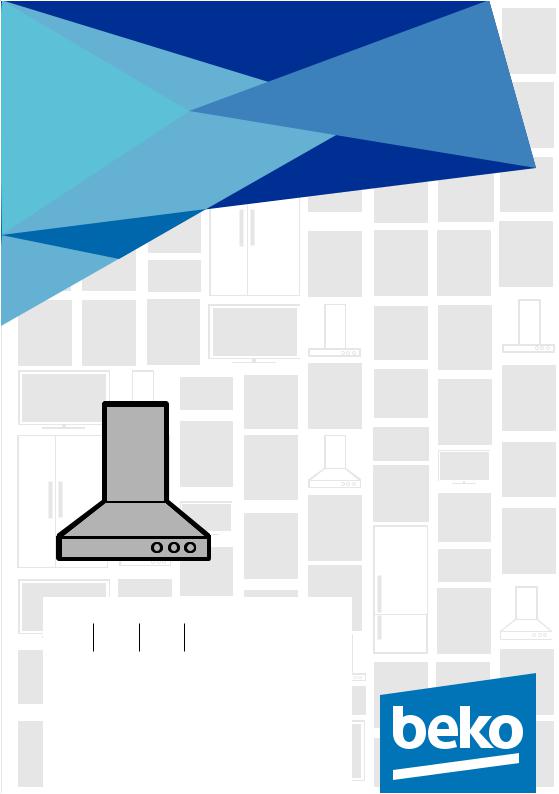
Range Hood |
User Manual |
CHS 30100 SS |
EN ES FR |
01M-8851223200-0316-06 |
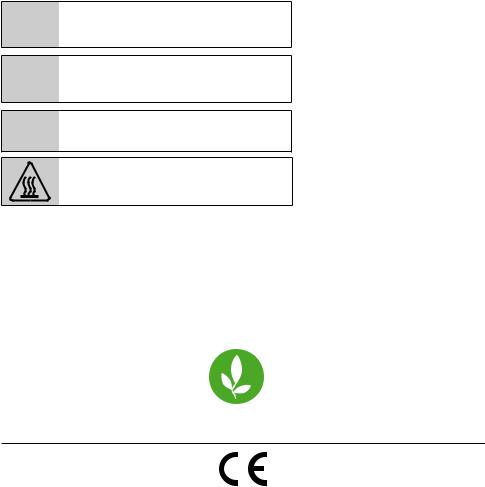
Please read this manual first!
Dear Customers!
Thank you for preferring a Beko product. We hope that you get the best results from your product which has been manufactured with high quality and state-of-the-art technology. Therefore, please read this entire user manual and all other accompanying documents carefully before using the product and keep it as a reference for future use. If you handover the product to someone else, give the user manual as well. Follow all warnings and information in the user manual.
Rememberthat this usermanualisalso applicablefor severalothermodels.Differences between the models are explicitly described in the manual.
Meanings of the Symbols
Following symbols are used in the various section of this manual:
C
WARNING: Warnings |
for |
dangerous |
A situations concerning the |
safety |
of life and |
property. |
|
|
B Warning for electric shock. |
|
|
Warning for hot surfaces. |
|
|
This product has been manufactured in environmental friendly modern plants without giving any harm to the nature.
This appliance conforms to the WEEE regulation.
It does not contain PCB.
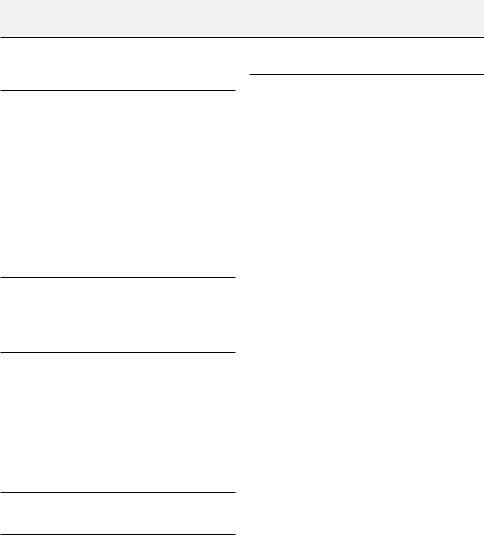
CONTENTS
1 Important safety and environmental instructions 4
1.1 General safety . . . . . . . . . . . . . . . . . . . . . . . . . . . . . .4 1.1.1 Electrical safety . . . . . . . . . . . . . . . . . . . . . . . . . . .4 1.1.2 Product safety . . . . . . . . . . . . . . . . . . . . . . . . . . . . 5 1.1.3 Children's safety . . . . . . . . . . . . . . . . . . . . . . . . . . 6 1.2 Intended use. . . . . . . . . . . . . . . . . . . . . . . . . . . . . . . . 6 1.3 Compliance with WEEE Directive and disposing of the waste product . . . . . . . . . . . . . . . . . . . . . . 7 Compliance with RoHS Directive:. . . . . . . . . . . . . . . 7 1.4 Package information. . . . . . . . . . . . . . . . . . . . . . . . 7
6 Cleaning and maintenance 17
6.1 Maintenance. . . . . . . . . . . . . . . . . . . . . . . . . . . . . . .17 6.2 Cleaning . . . . . . . . . . . . . . . . . . . . . . . . . . . . . . . . . . .17 6.3 Grease Filter . . . . . . . . . . . . . . . . . . . . . . . . . . . . . . .17 6.4 Replacing the light bulb . . . . . . . . . . . . . . . . . . .17 6.5 Charcoal Filter . . . . . . . . . . . . . . . . . . . . . . . . . . . . .18 6.6 Charcoal filter placement (Recirculating accessories) . . . . . . . . . . . . . . . . . . . . . . . . . . . . . . . . . . .18
7 Warranty |
19 |
|
|
2 Electrical & Installation |
8 |
requirements |
2.1 Electrical requirements . . . . . . . . . . . . . . . . . . . . .8 2.2 Before installing the hood . . . . . . . . . . . . . . . . . .8
3 Technical specifıcations of your |
|
appliance |
9 |
3.1 List of Materials. . . . . . . . . . . . . . . . . . . . . . . . . . . . . 9 3.1.1 Parts supplied . . . . . . . . . . . . . . . . . . . . . . . . . . . . . 9 3.1.2 Parts not supplied. . . . . . . . . . . . . . . . . . . . . . . . . 9 3.2 Dimensions and Clearances . . . . . . . . . . . . . . . . 9 3.3 Ducting Options and Examples . . . . . . . . . . . .10 3.3.1 Venting methods . . . . . . . . . . . . . . . . . . . . . . . .10 3.4 Preparation. . . . . . . . . . . . . . . . . . . . . . . . . . . . . . . . 11
4 Installing your appliance |
12 |
4.1 Installation - Ducting version . . . . . . . . . . . . . .12
5 Operating your appliance |
16 |
5.1 Description of the hood & Controls . . . . . . . .16 5.1.1 Controls . . . . . . . . . . . . . . . . . . . . . . . . . . . . . . . . . .16 5.1.2 Description of control panel . . . . . . . . . . . . .16
Range Hood / User Manual |
3 / 56 EN |
|
|

1Important safety and environmental instructions
This section contains safety instructions that will help protect from risk of personal injury or property damage. Failure to follow these instructions invalidates the granted warranty.
1.1 General safety
•Always have the installation and repairing procedures carried out by the Authorized Service Agent. Manufacturing firm shall not be held responsible for damages that may be caused by unauthorized persons.
•This appliance is not intended for use by persons (including children) with reduced physical, sensory or mental capabilities, or lack of experience and knowledge. Children should be supervised to ensure that they do not play with the appliance.
1.1.1 Electrical safety
•Always unplug the appliance from the mains supply during installation, maintenance, cleaning and repair operations.
•If the power cable is faulty, it should be replaced by a qualified person certified by the manufacturer, after-sales service or similar (preferably an electrician) or a person described by the importer.
•Operating voltage is 220 to 240 volts.
•If the appliance has a failure, it should not be operated unless it is repaired by the Authorized Service Agent. There is the risk of electric shock!
•Do not route power cable close to hobs. Otherwise power cable may cause fire since it melts down easily.
•Never plug the hood before installation is completed.
•In order to obtain the best performance, external conductor must not be longer than 4 m. It must not contain more than 2 perpendicular (90°) angles and its diameter must be min. ø120 mm.
•Disconnect the appliance from mains before any intervention to the internal parts of the appliance.
•Use the appliance with a grounded outlet only.
4 / 56 EN |
Range Hood / User Manual |
|
|

1Important safety and environmental instructions
1.1.2 Product safety
•You can use a pipe with a diameter of 120 mm or 150 mm on the flue connection of the hood.
•Do not make connections to the flues connected with stoves, exhaust shafts or flues with rising flames. Observe the rules set by authorities on the discharge of exhaust air.
•The height between the lower surface of the hood and upper surface of the stove/oven should not be less than 50 cm for gas hobs and 45 cm for electric hobs.
•Do not operate the hood without aluminum filters and do not remove the filters while it is operated.
•Never touch the hood's lamps after they are operated for a long time. Hot lamps may burn your hand.
•Avoid large flames beneath the product. Otherwise, particles on oil filter may ignite and lead to a fire.
•Turn on the hobs after placing pans or pots on it. Otherwise, rising heat may deform certain parts of your product.
•Turn off the hobs before taking away pans or pots.
•Avoid inflammable materials under the hood.
•Oil may ignite while frying foods. Therefore, be careful about cloths and curtains.
•Never leave the cooker unattended when frying foods; otherwise hot oil may cause fire.
•There is the risk of fire if your hood is not cleaned in the specified periods.
•Be extremely careful and wear gloves when cleaning the hood.
•We advise you to operate the appliance a few minutes before starting to cook in order to increase the suction power. Thus, you shall have a continuous and stable suction power when the vapors arise.
•Operate your hood for 15 minutes more after the end of cooking or frying in order to remove the smell and cooking vapor in the kitchen.
•When the hood is in use, especially together with gas cookers, make sure that environment is ventilated with clean air.
Range Hood / User Manual |
5 / 56 EN |
|
|

1Important safety and environmental instructions
•Pay attention not to connect the appliance to the flues used by non-electrical devices. (E.g.: Heater flue).
•Simultaneous and smooth operation of the hood and another device that require air is only possible when a low pressure of 4 Pa (0.04 mbar) is reached, and thus the reabsorption of the gas is avoided. This can only be achieved by means of air coming from uncovered openings (door, window, ventilation openings or other technical measures). Pay utmost attention to provide sufficient air flow. A flue that provides air ingress/egress is not enough for this purpose.
1.1.3 Children's safety
•Packaging materials are dangerous to children. Keep packaging materials in a safe place out of reach of children.
•Electrical appliances are dangerous to children. Keep children away from the product. Do not allow children play with the appliance.
•This appliance can be used by the children who are at the age of 8 or over and by the people who have limited physical, sensory or mental capacity or who do not have knowledge and experience, as long as they are supervised with regard to safe use of the product or they are instructed accordingly and understand the risks of using the product. Children should not play with the appliance.
•CAUTION: Accessible parts may heat up when used with a cooking device.
1.2 Intended use
•This appliance is intended for domestic use. It is not suitable for commercial use and it must not be used out of its intended use.
•The manufacturer shall not be liable for any damage caused by improper use or handling.
•Service life of your appliance is 10 years. This is the period required for availability of spare parts for proper functioning of the product.
6 / 56 EN |
Range Hood / User Manual |
|
|
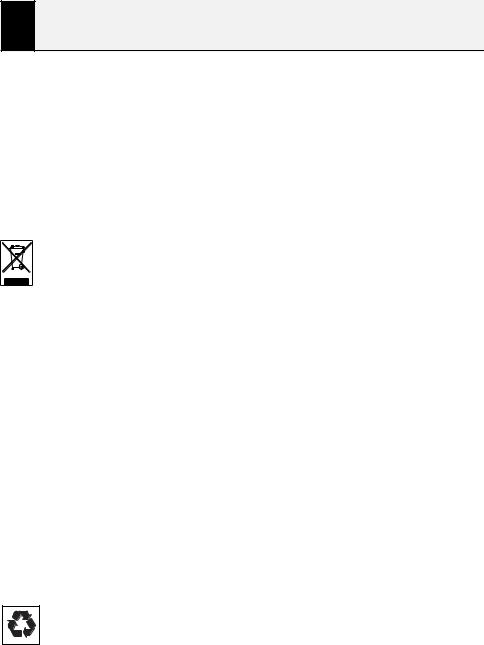
1Important safety and environmental instructions
•WARNING: Failure to fix the screws in concordance with the instructions provided in the manual may lead to electrical hazards.
1.3 Compliance with WEEE Directive and disposing of the waste product
This product complies with EU WEEE
Directive (2012/19/EU). This product
bears a classification symbol for waste
electrical and electronic equipment (WEEE).
This product has been manufactured with high quality parts and materials which can be reused and are suitable for recycling. Do not dispose of the waste product with normal domestic and other wastes at the end of its service life. Take it to the collection center for the recycling of electrical and electronic equipment. Please consult your local authorities to learn about these collection centers.
Compliance with RoHS Directive:
The product you have purchased complies with EU RoHS Directive (2011/65/EU). It does not contain harmful and prohibited materials specified in the Directive.
1.4 Package information
Package of the product is made of recyclable materials in accordance with our National Legislation. Do not dispose
of the packaging materials together with the domestic or other wastes. Take them to the packaging material collection points designated by the local authorities.
Range Hood / User Manual |
7 / 56 EN |
|
|
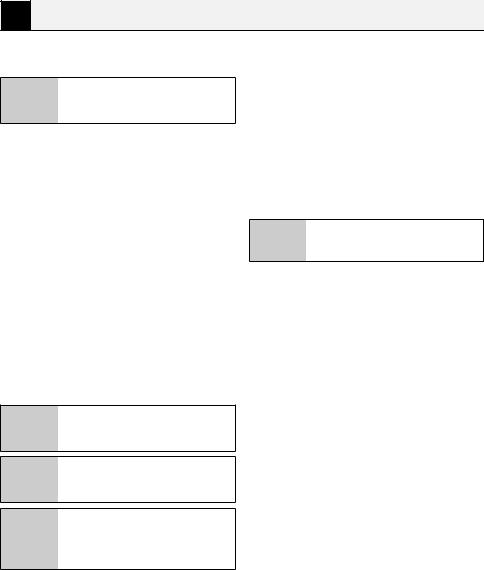
2 Electrical & Installation requirements
2.1 Electrical requirements
C Observe all governing codes and ordinances.
It is the customer’s responsibility:
To contact a qualified electrical installer. To assure that the electrical installation is adequate and in conformance with National Electrical Code, ANSI/NFPA 70 — latest edition*, or CSA Standards C22.1-94, Canadian Electrical Code, Part 1 and C22.2 No.0-M91 - latest edition** and all local codes and ordinances.
•• If codes permit and a separate ground wire is used, it is recommended that a qualified electrician determine that the ground path is adequate.
•• Do not ground to a gas pipe.
•• Check with a qualified electrician if you are not sure range hood is properly grounded.
•• Do not have a fuse in the neutral or ground circuit.
C Save Installation Instructions for electrical inspector’s use.
C The range hood must be connected with copper wire only.
The range hood should be C connected directly to the fused disconnect (Or circuit breaker) box
through metal electrical conduit.
Wire sizes must conform to the requirements of the National Electrical Code ANSI/NFPA 70 — latest edition*, or CSA Standards C22.1-94, Canadian Electrical Code Part 1 and C22.2 No. 0-M91 - latest edition** and all local codes and ordinances.
A U.L.- or C.S.A.-listed conduit connector must be provided at each end of the power supply conduit (at the range hood and at the junction box).
Copies of the standards listed may be obtained from:
*National Fire Protection Association Batterymarch Park Quincy, Massachusetts 02269
**CSA International 8501 East Pleasant Valley Road Cleveland, Ohio 44131-5575
2.2 Before installing the hood
1.For the most efficient air flow exhaust, use a straight run or as few elbows as possible.
A WARNING: Vent unit to outside of building, only.
2.At least two people are necessary for installation.
3.The hood is fitted with Screws and Drywall Anchorssuitable for most surfaces, consult a Qualified Installer,check if they perfectly fit with your cabinet/wall.
4.Do not use flex ducting.
5.COLD WEATHER installations should have an additionalbackdraft damper installed to minimize backward cold airflow and a nonmetallic thermal break to minimizeconduction of outside temperatures as part of theductwork. The damper should be on the cold air side ofthe thermal break.The break should be as close as possible to where theducting enters the heated portion of the house.
6.Make up air: Local building codes may require the use of Make-Up Air Systems when using Ducted Ventilation Systems greater than specified CFM of air movement. The specified CFM varies from locale to locale. Consult your HVAC professional for specific requirements in your area.
8 / 56 EN |
Range Hood / User Manual |
|
|

3 Technical specifıcations of your appliance
3.1 List of Materials |
3.2 Dimensions and |
|||
3.1.1 Parts supplied |
Clearances |
|||
|
||||
•• Hood Canopy Assembly with Round Metal |
|
|||
Transition installed |
|
|
|
|
•• Rectangular Metal Transition with Back draft |
|
|||
dampers |
|
|
|
|
•• Care & Use / Installation Instructions |
|
|||
•• 2 Filters |
|
|
|
|
•• Fitting Screws |
|
|
|
|
3.1.2 Parts not supplied |
|
|||
•• Duct, conduit and all tools required for |
|
|||
installation. |
|
|
|
|
•• Ductless Recirculating Kit |
|
|||
•• To be used only in the Ductless (Recirculating) |
|
|||
version |
|
|
|
|
•• includes: charcoal filter |
|
|
|
|
|
|
|
|
|
|
|
CHS30100SS |
|
|
|
|
|
|
|
Operating mode |
|
convertible : ducted/ |
|
|
|
|
recirculated |
|
|
Max. Ventilation |
|
240 CFM |
|
|
Capacity |
|
|
|
|
Nr.of Speeds |
|
3 |
|
|
Controls |
|
Electronical Tact Switches |
|
|
Lights |
|
2 x 50 W Halogene |
|
|
Filtering |
|
2 x Aluminum Mesh |
|
|
Volts |
|
120 V |
|
|
Frequency |
|
60 Hz |
|
|
Total Power |
|
260 W |
|
|
(motor + lamps) |
|
|
|
|
Plug type |
|
Hard Wire |
|
|
Required dis- |
|
30” (gas cooktop) |
|
|
tance above |
|
|
|
|
|
24” (electrical cooktop) |
|
|
|
cooktop |
|
|
|
|
|
|
|
|
|
Range Hood / User Manual |
9 / 56 EN |
|
|

3 Technical specifıcations of your appliance
3.3 Ducting Options and Examples
Closely follow the instructions set out in this manual.
Allresponsibility,foranyeventualinconveniences, damages or fires caused by not complying with the instructions in this manual, is declined.
3.3.1 Venting methods
Vent Exhaust Option
The hood is designed for vertical or horizontal discharge or can be installed in a recirculating ductless version:
Vertical discharge:
Use a rectangular duct 3 1/4” x 10” or use a round 7” duct.
Horizontal discharge:
Use a rectangular duct 3 1/4” x 10” Recirculating (non vented ductless)
For ductless (Recirculating) version
C only: purchase the Ductless
Recirculating Kit. Minimum Duct
Size (Ducting/Ductless version): 7”
Round Pipe.
10 / 56 EN |
Range Hood / User Manual |
|
|
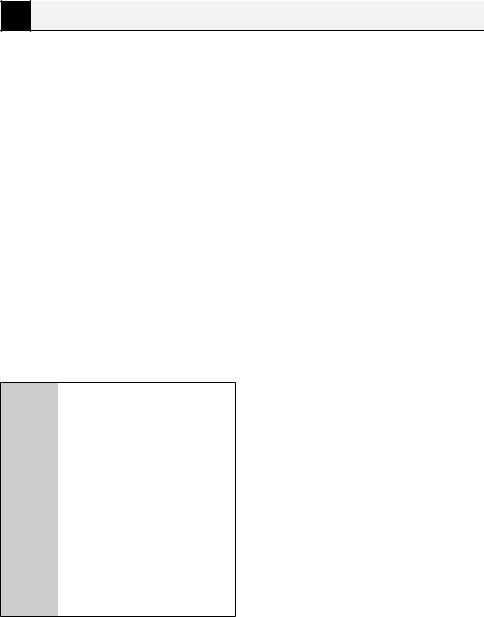
3 Technical specifıcations of your appliance
3.4 Preparation
Do not cut a joist or stud unless absolutely necessary. If a joist or stud must be cut, then a supporting frame must be constructed.
Fittings material is provided to secure the hood to most types of walls/ceilings.
However, a qualified technician must verify suitability of the materials in accordance with the type of wall/ceiling.
Before making cutouts, make sure there is proper clearance within the ceiling or wall for exhaust vent.
Hood installation height above cooktop is the users preference. The lower the hood is above the cooktop, the more efficient the capturing of cooking odors, grease and smoke.
WARNING: For gas ranges ınstallatıon: mount thıs hood so that the bottom edge ıs at 30” (76,2 cm) abovethecookıngsurface.
For electrıc ranges A ınstallatıon: mount thıs hood so that the bottom ıs not less than 24” (61 cm) and not more that 30” (76,2 cm) above the
cookıng surface.
Household use. Please, read ınstallatıon manual for specıfıc applıcatıon.
Check your ceiling height and the hood height maximum before you select your hood.
Range Hood / User Manual |
11 / 56 EN |
|
|
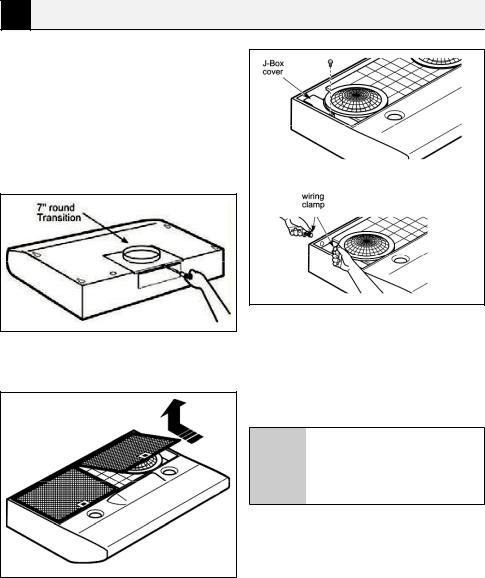
4 Installing your appliance
4.1 Installation - Ducting version
After having choosen the vent option, proceed as follows:
Step 2
Remove the round transition from its seat by unscrewingtheitsfixingscrews(savethescrews).
Step 3
Remove the grease filters.
Step 4
Remove the junction box cover.
Remove either the top or the back wiring knockout according the preference and install an approved wiring clamp
Step 5
Remove the duct knockouts using a flat blade screwdriver and a small hammer.
Use the screwdriver by knocking out the pannel in similar fashion to a scalpel.
Take care of sharp edges.
If it is intended to use the hood in C the recirculating version do not remove any duct knockouts and order the necessary charcoal filter
from your supplier.
R1 = Remove rectangular duct knockout only.
R2 = Remove semicircular and rectangular duct knockouts
12 / 56 EN |
Range Hood / User Manual |
|
|
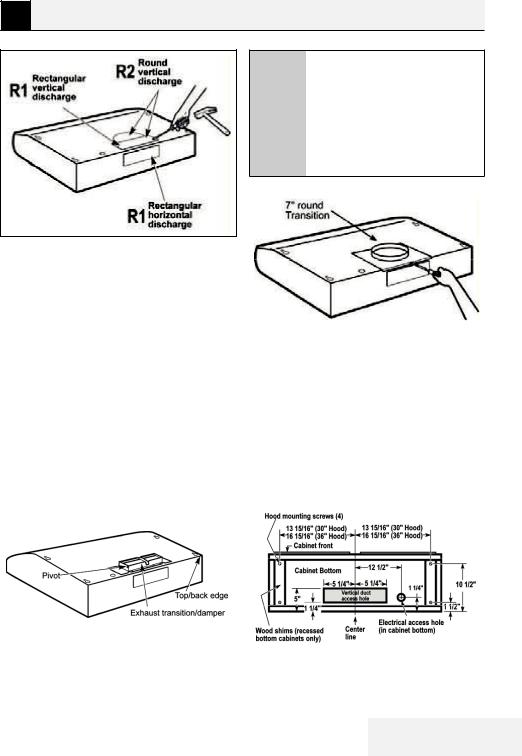
4 Installing your appliance
The round transition can be installed up to 1 inch on either side of the hood center to accommodate
C off-center ductwork. In extreme offcenter installations, one end of the duct connector may need to be trimmed to clear the electrical cable clamp.
Step 6 |
|
|
|
|
For rectangular ducted discharge installations |
|
|
|
|
only (otherwise skip to next step) |
|
|
|
|
Attach exhaust adaptor/damper over knockout |
|
|
|
|
opening with two exhaust adaptor screws. Make |
|
|
|
|
sure damper pivot is nearest to top/back edge of |
Step 8 |
|
||
hood. |
Mark holes |
|
||
Remove tape from damper flap. |
|
|||
Select the vent option that your installation will |
|
|||
|
|
|
||
|
|
require and proceed to that section: |
|
|
|
The exhaust adaptor/damper can be |
|
||
|
installed up to 1 inch on either side |
Outside top exhaust |
|
|
C |
of the hood center to accommodate |
(Vertical duct– 3 1/4”x 10” Rectangular) Use the |
|
|
off-center ductwork. In extreme |
|
|||
diagram or the hood as a template and mark the |
|
|||
offcenter installations, one end of |
|
|||
|
the duct connector may need to be |
locations on the cabinet for ductwork, electrical |
|
|
|
wiring and keyhole screw slots. |
|
||
|
trimmed to clear the electrical cable |
|
||
|
clamp. |
|
|
|
|
|
|
|
|
|
|
|
|
|
|
|
|
|
|
|
|
|
|
|
13 / 56 EN
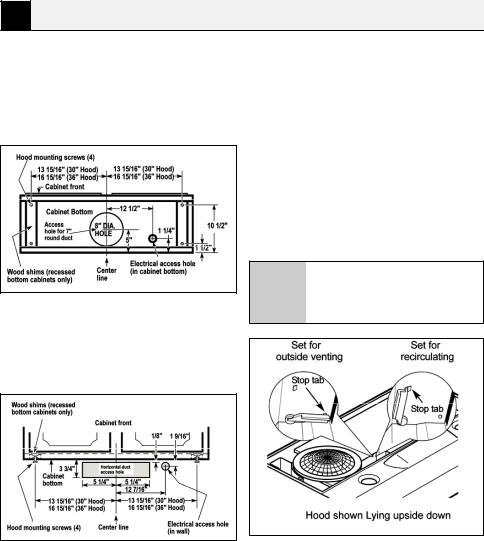
4 Installing your appliance
Outside top exhaust
(Vertical duct–7” Round)
Use the diagram or the hood as a template and mark the locations on the cabinet for ductwork, electrical wiring and keyhole screw slots.
Outside rear exhaust
(Horizontal duct– 3 1/4”x 10” Rectangular)
•• Use the diagram or the hood as a template and mark the locations on the cabinet for ductwork, electrical wiring and keyhole screw slots.
Recirculating
Use the hood as a template and mark the locations on the cabinet for the electrical wiring and keyhole screw slots.
Since the hood is to be recirculated (not to be vented outside), do not cut out any vent openings in the wall or cabinet bottom.
Step 9
Choose Venting Option
The hood can be set to vent outside or to recirculate air back into the kitchen.
The plastic vent lever is located near the center of the hood opening.
To vent to the outside, make sure the plastic vent lever is in the HORIZONTAL position (flat against the metal top of the hood).
To recirculate air into the kitchen, make sure the plastic vent lever is in the VERTICAL position (flat against the plastic blower housing).
In order to change the vent lever C position, you will need to pull the lever out slightly to clear the plastic
tabs.
Step 10
For recessed bottom cabinet only
If the cabinets have front, side or back trim, make 2 wood shims the width of the trim and attach them to the cabinet bottom recess on both sides. See previous page for marking locations.
14 / 56 EN |
Range Hood / User Manual |
|
|

4 Installing your appliance
Step 11
Cut holes at marked locations for duct and electrical wiring. For the vertical duct, cut out 3/4” extra toward the front of the cabinet so you can move the duct freely when installing the hood.
It may also ease installation by cutting the hole 10 1/ 2” instead of 10”.
Step 12
Drive a mounting screw (from the hardware packet) partway into each center of the narrow neck of the keyhole slots marked on the cabinet bottom.
Step 13
Fix the wiring conduit to the hood.
Step 14
Slide the hood back against the wall. Tighten the mounting screws. Be sure the screw heads are in the narrow neck of the keyhole slot.
Connect Ductwork to hood.
Step 15.
Electrical connection
WARNING: Electrical Shock Hazard
A Turn off power circuit at the service panel before wiring this unit.
120 VAC, 15 or 20 Amp circuit required.
Electrical grounding instructions
This appliance is fitted with an electrical junction box with 3 wires, one of which (green/yellow) serves to ground the appliance.
To protect you against electric shock, the green and yellow wire must be connected to the grounding wire in your home electrical system, and it must under no circumstances be cut or removed.
Failure to do so can result in death or electrical shock.
Remove the knockout and the Junction box cover and install the conduit connector (cULus listed) in junction box.
Run 3 wires; black, white and green ,according to the National Electrical Code and local codes and ordinances, in 1/2” conduit from service panel to junction box.
Connect black wire from service panel to black or red in junction box, white to white and green to green-yellow.
Close and secure junction box cover.
Step 16
Final installation steps Replace filters.
Check operation of the hood.
If range hood does not operate:
•• Check that the circuit breaker is not tripped or the house fuse blown.
•• Disconnect power supply. Check that wiring is correct.
To get the most efficient use from your new range hood, read the “Use and Care Information” section.
Keep your Installation Instructions and Use and Care Guide close to range hood for easy reference.
Range Hood / User Manual |
15 / 56 EN |
|
|

5 Operating your appliance
5.1 Description of the hood & Controls
1.Blower and light controls
2.Halogen lamp housings
3.Grease filter Handle
4.Grease filter
5.1.1 Controls
Use the high suction speed in cases of concentrated kitchen vapours. It is recommended that the cooker hood suction is switched on for 5 minutes prior to cooking and to leave in operation during cooking and for another 15 minutes approximately after terminating cooking.
5.1.2 Description of control panel
1.ON/OFF Light
2.ON/OFF general and speed1.
3.ON/OFF, speed 2 and speed 3.
16 / 56 EN |
Range Hood / User Manual |
|
|

6 Cleaning and maintenance
6.1 Maintenance
Before performing any maintenance operation, isolate the hood from the electrical supply by switching off
C at the connector and removing the connector fuse.
Or if the appliance has been connected through a plug and socket, then the plug must be removed from the socket.
6.2 Cleaning
•• Do not spray cleaners directly to the control while cleaning the Hood.The cooker hood should be cleaned regularly (at least with the same frequency with which you carry out maintenance of the fat filters) internally and externally. Clean using the cloth dampened with neutral liquid detergent. Do not use abrasive products. DO NOT USE ALCOHOL!
WARNING: Failure to carry out A the basic cleaning recommendations of the cooker hood and replacement of the filters may cause fire
risks.
•• Therefore, we recommend oserving these instructions.
•• The manufacturer declines all responsibility for any damage to the motor or any fire damage linked to inappropriate maintenance or failure to observe the above safety recommendations.
6.3 Grease Filter
Traps cooking grease particles.
This must be cleaned once a month using non aggressive detergents, either by hand or in the dishwasher, which must be set to a low temperature and a short cycle. When washed in a dishwasher, the grease filter may discolour slightly, but this does not affect its filtering capacity.
To remove the grease filter, pull the spring release handle.
6.4 Replacing the light bulb
Before replacing the lamps, switch C power off at service panel and lock service panel disconnecting means to prevent power from being
switched on accidentally.
Turn off the lights and fan. Allow C the lights to cool before handling.
If new lights do not operate be sure lights are inserted correctly before calling service.
Replace Lights
•• Remove the damaged light (twist counter clockwise) and replace with a new 120 Volt, 50 Watt (maximum) 50° halogen light made for a GU10 base, suitable for use in open luminarie.
Range Hood / User Manual |
17 / 56 EN |
|
|
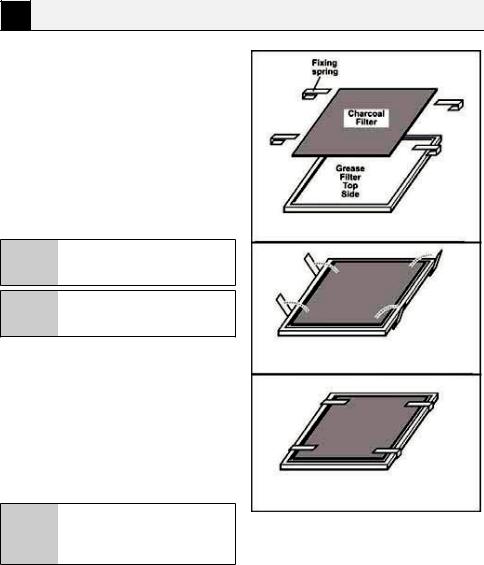
6 Cleaning and maintenance
6.5 Charcoal Filter
•• If the model is not vented to the outside, the air will be recirculated through disposable charcoal filters that help remove smoke and odors.
•• The charcoal filters cannot be cleaned.
•• They must be replaced.
•• The charcoal filters are clipped inside of each metal grease filter (mounting instructions included with charcoal filters kit). The charcoal filters should be replaced every 4-6 months (depending on hood usage).
C DO NOT rinse, or put charcoal filters in an automatic dishwasher.
C Charcoal filters are not included with the hood.
•• They must be ordered from your supplier.
•• Order the needed kit specifying your hood model and width size.
6.6 Charcoal filter placement (Recirculating accessories)
•• Fit the charcoal filter mattress on the upper side of each grease filter.
•• Use provided springs to fix it in place.
When removing for replacing for C a new one do not remove Fixing Springs, simply pull out one and
rotate outwards.
18 / 56 EN |
Range Hood / User Manual |
|
|
